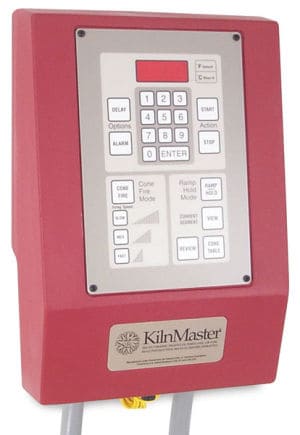Your cart is currently empty!
Buying a Used Kiln – 12 Top Tips on Second Hand Kilns
Published:
Last Updated:
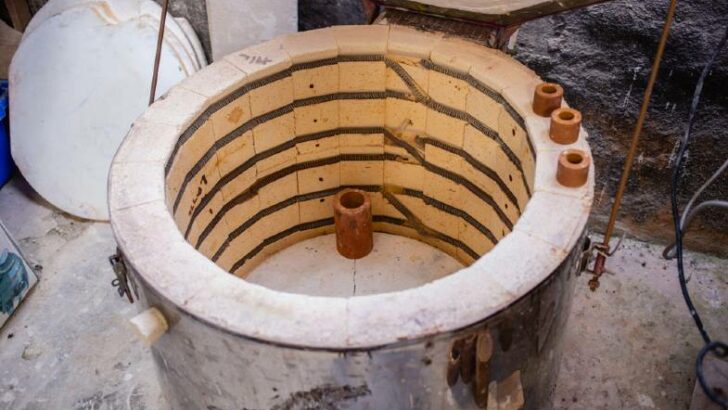
Affiliate Disclaimer
As an affiliate, we may earn a commission from qualifying purchases. We get commissions for purchases made through links on this website from Amazon and other third parties.
Buying your first kiln is exciting, but it can also be confusing. A lot of times when you look at listings for used kilns, the information in the advert can be patchy. However, even buying a used kiln can be a big investment. So, it’s good to have an idea of what to look for. This article is all about what to look out for when choosing a second-hand kiln.
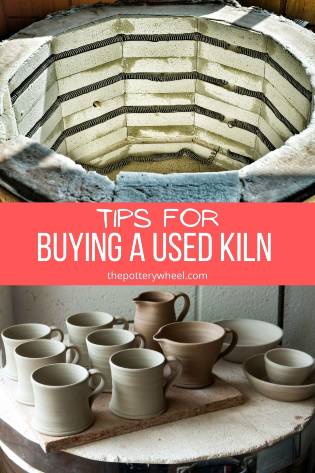
Buying a Used Kiln
Here are 12 handy tips to bear in mind when buying a used kiln.
Tip 1) Checking the Size of the Kiln
It sounds obvious but it’s important to know that you have enough space for a kiln before you buy it. It can be hard to gauge the size of a kiln from a photo. Something that looks quite compact can actually turn out to be a lot larger than you thought. And vice versa, a kiln that looks large in the photo can actually be small when you check the measurements.
External Kiln Measurements
So, check the external dimensions, height, width, and breadth. When you’re deciding where you are going to install your kiln, you need to have quite a bit of space. Some manufacturers recommend leaving 12 inches of clearance around all sides of your kiln. But a lot will actually recommend leaving a good 18 inches to be on the safe side.
This means that the kiln needs to be 18 inches away from surrounding walls and surfaces at all angles. The surface of a kiln does get hot when it’s firing. So, you need to be sure that there is nothing flammable like curtains or carpets nearby.
Kilns will have anything from 2-3.5 inches of insulation around the sides, top, and bottom. So, quite a small internal chamber can have quite large external measurements. Then on top of that, you are advised to have 18 inches clearance all the way around the kiln. As such, even a small kiln can take up a lot of space in a room.
So, check the external measurements of the kiln. Use a tape measure and make sure you have enough space. Better still draw out the measurements on a piece of paper. Then put that on the floor of your intended kiln space. This will give you a good sense of how much of the room the kiln would use.
Internal Kiln Measurements
Photographs of the insides of kilns can be unintentionally deceptive. An internal chamber that looks quite roomy can actually be very small.
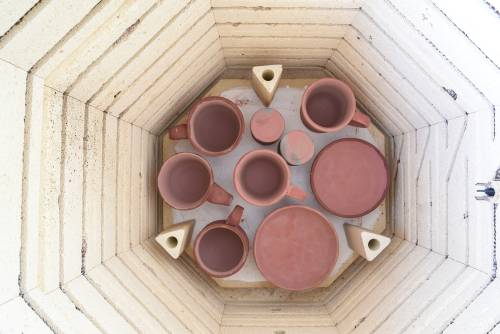
It’s a waste of time to go and look at a kiln in person only to find it’s way too small. So, check the internal measurements. It can help to make a cardboard box with the same measurements as the inside of the kiln. This will give you a very good idea of how much work you will be able to fit in at one time.
If you make a cardboard mock-up, you might realize that a kiln that sounds perfect only accommodates four mugs. It may be that this is all you need. If you produce smaller quantities of work, or if you make very small pieces like jewelry, this would be ok. But if your pottery hobby is expanding, buying a very small kiln will probably feel frustrating.
So, if the person advertising the used kiln hasn’t included internal measurements, be sure to ask for them.
Size Matters
The perfect sized kiln for you will depend on a number of factors. If you buy a very small kiln, you are more likely to outgrow it and feel frustrated by its limitations.
However, lots of potters start off buying smaller kilns. Then when they upsize, they keep the small kiln as a tester kiln. Tester kilns are useful for trying out new glazes or firing schedules.
Also, it can take a while to figure out the best way to fire your clay and glazes. All kilns are different and used kilns in particular heat up at different rates. So, it can take a while to figure out the best firing schedule for your work.
Learning how to fire your pottery in a large used kiln will take longer. It takes longer to fill a big kiln. And if you aren’t happy with the results, you will have lost more pottery than in a smaller kiln.
Tip 2) What Type of Used Kiln to Buy
There are a lot of different types of kiln. And, if you want to buy a pottery kiln be sure that that is what’s being sold.
It sounds like an obvious point, but often listings for kilns will have scant information. The person selling the kiln may not even know what kind of kiln it is. Perhaps they are selling it for a friend or relative.
Some kilns are designed for firing glass, some for metal, and some for pottery. Check that the used kiln is suitable for firing pottery.
Tip 3) Power Requirements
A related point is how you are going to power the kiln. If you want to buy a used gas kiln, you will need a natural gas supply. And unless you are a registered gas technician, you will need a specialist to install the gas kiln.
Most kiln second-hand kilns are electric kilns. This is because electric kilns are by far the most common way of firing pottery, especially among hobby potters.
You need to check that the electrical supply to your building is enough to support using a kiln.
Electrical Requirements When Buying a Used Kiln
There are 3 main things that you need to consider about the kiln’s electrical requirements. They are:
- What amps does it draw?
- Voltage requirements
- Single-phase or 3-phase power
Most of the time, kilns will have a metal panel screwed onto the electrical box with this information.
Amps
The amps a used kiln draws is the volume of electricity it needs to work properly. All properties will be supplied with a particular volume of electricity. Most homes will be supplied with 100 or 200 amps depending on how old the property is.
It’s important to know how many amps a used kiln requires. Some small kilns can be plugged into a domestic socket in the wall. However, most kilns require more power than this and will need additional wiring. This wiring will need to form its own separate circuit and have its own breaker switch.
It’s normally recommended that the breaker switch is 20-25% larger than the amps required by a kiln. So, if your kiln specification states that it draws 48 amps, you would need to get a 60 amp breaker.
If you don’t know anything about electricity or the power supply to your property, ask an electrician. An electrician will also be able to wire the kiln in for you. And they will be able to advise you about what kind of socket you need.

The number of amps a kiln requires is an important piece of information. Let’s say the power supply to your house is 100 amps. If you buy a 60 amp kiln, it will be using most of your power supply. Whilst the kiln is running, you won’t be able to run your dishwasher, tumble drier and electric oven at once.
If you’re only planning on firing the kiln a couple of times a month, this may not be an issue. But if you expect to fire more regularly, a kiln with a large amperage requirement might be an issue.
Volts
Put simply, for non-electricians like myself, volts are the amount of pressure that the electrical current is under. The standard voltage for a property varies between countries.
In the US, most residential properties are supplied with 240V. However, this power supply is transformed into 120V for most electrical outlets in the home. So, whilst the majority of everyday sockets are 120V, a home will most likely have a 240V supply available too.
Some smaller kilns will run on 120V and can be plugged into a standard socket. However, most larger kilns are likely to need 240V. A qualified electrician would be able to install a 240V socket where you need it.
Single Phase or 3 Phase Power
Almost all domestic electrical supplies are single phase. Some commercial buildings and larger properties like schools have 3 phase electricity.
Most small and medium-sized kilns require a single phase electrical supply. Some larger production kilns require 3 phase electricity, and some have the option for either. Most used kilns that are suitable for hobby potters and smaller production will be single phase. But it’s worth checking this out before you buy.
Tip 4) What Temperature Does the Kiln Fire to?
Most kilns will specify their maximum temperature on the side panel. It’s important to check the maximum temperature that a kiln fires to. There is a lot to consider when you are buying a used kiln. And it’s easy to forget the obvious when you find a kiln that looks exciting. But you don’t want to buy a kiln that fires to earthenware temperatures if you plan to fire stoneware.
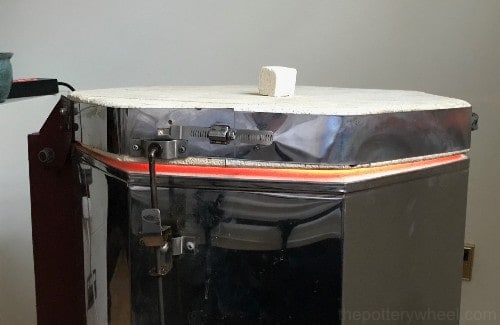
Another thing to consider is that used kilns are often less efficient than new kilns. Used kilns are generally older and have wear and tear. This means that they can struggle at higher temperatures. The official spec of a used kiln might state that it fires to 2250F. However, if it’s elderly, it might take the kiln longer to get into that temperature range.
This isn’t necessarily a problem. It’s generally accepted that an older used kiln will take longer to fire at higher temperatures. However, it does mean that you will use more electricity firing your pottery.
Trial and Error with a Used Kiln
Because an older used kiln is less efficient you may need to experiment when you start firing your pottery. Firing clay isn’t just about reaching a certain temperature. It’s also about how long it takes to get there. Clay matures and becomes ceramic through heatwork. This is a combination of the temperature reached and the time it takes to fire a piece.
If it takes longer for a kiln to get to the target temperature, then the pottery will receive more heatwork.
Let’s say your target temperature is 2250F. You can program a kiln to climb at a particular number of degrees per hour. This is part of the firing schedule.
But if your older used kiln starts to struggle over 2015F the climb rate may slow down. As a result, the pottery is being held at higher temperatures for longer. This means that it’s getting more heatwork.
You may set a target temperature of 2232F. In pyrometric cone terms, this is cone 6. But your used kiln might get slower at higher temperatures. So, by the time it’s got to the target temperature, it may have had more heatwork than cone 6.
Because older kilns have their own individual quirks, it’s a good idea to use pyrometric cones when you are firing. The pyrometer might tell you the kiln got to cone 6 temperatures. But your cones will tell you if your pottery got cone 7’s worth of heatwork.
Cones are easy to use and they are very helpful, especially when you are buying a used kiln. Here is an article all about how to use pyrometric cones.
Tip 5) What Type of Controller Does it Have?
A kiln can have 3 types of controls. They are:
- Manual controls are buttons and switches that you need to manually adjust as the pottery is firing.
- Digital controllers are little computers that allow you to program your kiln to fire to a set schedule.
- Kiln sitters are mechanical devices that use a pyrometric cone to control when the kiln switches off.
A lot of second hand older kilns either have a manual controller or a kiln sitter. Digital kiln controllers are a more recent development in kiln design. So, if you find a used kiln with a digital controller, it probably won’t be that old.
As a result, used kilns with digital controllers tend to be much more expensive.
You can buy external programmable controllers that connect to older kilns. Orton and Skutt both make digital controllers that you can connect to an older kiln. I use a Stafford controller on my kiln, which works on the same principle.
A Word about Kiln Sitters
There are quite a lot of used kiln sitter kilns for sale. This is because they are usually older models. Kiln sitters are mechanical devices.
Simply put, there is a narrow hole that goes from the outside to the inside of the kiln. A kiln sitter rod sits in the hole. The rod is supported on the inside of the kiln with a pyrometric cone. As the kiln heats up, the cone bends.
When the kiln has reached its target temperature, the cone will have bent enough to let the rod drop. The rod then operates a mechanism on the outside of the kiln, which switches the kiln off.
Because kiln sitters are older and mechanical, it’s a good idea to double-check that these are working properly. One thing to look out for is the diameter of the rod. If the rod is old and nearing the end of its life, it will be thinner at one end.
Converting a Kiln Sitter Kiln
If you are thinking of buying a used kiln that has a kiln sitter, you may get a bargain. You can either use the kiln sitter control. Or if you want a programmable device, you can replace the kiln sitter mechanism with an external digital controller.
External controllers are not cheap, so you need to factor that expense into your decision.
Tip 6) What Condition is the Kiln In?
If you’re buying a used kiln on eBay, it can be tempting to bid without seeing a kiln in person. It is much better to visit a kiln and take a look at it up close before you purchase it. Photos can be deceptive.
Here are some things to check when you are thinking of buying a used kiln:
The Elements:
These are the metal coils that heat the kiln. They sit in channels or grooves around the kiln. Elements have a life span and will need replacing eventually. This is normal, and old elements are not a reason to reject a kiln. However, if the elements are old, you need to factor in the cost of replacing them once the kiln is yours.
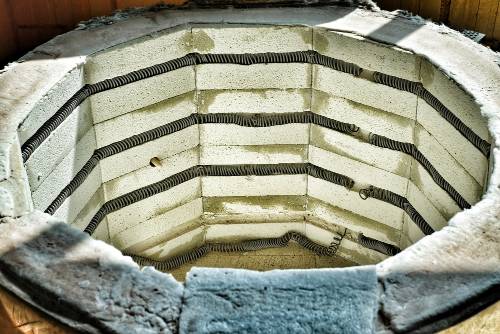
Healthy elements will look clean, neat, and will be sitting in the grooves on the inside of the kiln. Old elements that need replacing may look flattened, they might be leaning over, unraveling, or popping out of the grooves. Another sign of wear on tear on elements is signs of corrosion.
Checking the Elements
In addition to visually inspecting the elements, ask for the kiln to be turned on. This will allow you to check that the elements are heating up.
Ask for the kiln to be turned on and left to heat up for 10 minutes. Then you can open the kiln lid and have a look at the elements. The elements will have started to glow a little by that point.
Also, if the kiln has a pyrometer and temperature reader, you will see the temperature climbing steadily.
The Bricks:
Kilns are insulated with soft brick. This brick can be damaged very easily. It’s easy to damage the kiln bricks as you take kiln shelves in and out of the kiln. A few small dents or bumps are normal for an older kiln. But if there are big chunks missing in the insulating brick, this will affect the kiln’s ability to retain heat.
Similarly, cracks in the brick are normal for an older kiln. Especially across the base of the kiln. A fine hairline crack is not problematic. But a sizeable crack that will obviously let a lot of heat escape is not great.
Cracks and chips in kiln brick can be repaired using kiln cement. If you see a used kiln with a few dings at a good price, you may have found a bargain. The dings can be repaired. But if the brick is very cracked, crumbly, yellowing, and splattered with glaze, you are probably best to walk away.
Wiring:
With time the wiring on a kiln can get hard and brittle. This is because the kiln gets so hot, and the plastic ages. Check the flex and plug on the power supply, to see if it looks old or dangerous.
If you are confident with electrics you could remove the casing on the kiln box to check the wiring. When I was buying a used kiln, I removed the box to check the wiring. But I must confess, I’m not an electrician, and electrics make me nervous. I took a friend with me who knows about electrics. My electrician friend did a check for me and confirmed that the electrics were in good shape.
A lot of local electricians will check a kiln over for a small fee. If you intend to use them to wire the kiln in, they may come along and check it for free.
Rust and Corrosion:
What is the general condition of the kiln? Is it rusty and corroded on the outside, or does it look well cared for and maintained?
A rust-free kiln is not a guarantee that the kiln will work well. And likewise, some used kilns may not look shiny and pretty but work well. Nevertheless, if a kiln looks neglected it may have a host of issues that will drain your purse.
Catches and Hinges:
Have a look at all the hinges and catches on the kiln. These can be loose and wobbly on a used kiln. It may be easy to tighten the loose joint. But equally, it’s good to know if the catch that holds the kiln lid up is at the end of its life.
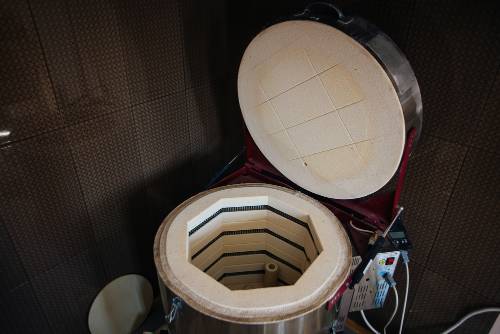
Tip 7) How Old is the kiln and What’s its History?
If a kiln is well looked after and well maintained, it can last for a long time. However, kilns do need maintenance. Can the seller show you a log of work done to the kiln? Do they have receipts for the most recent set of elements or any work they’ve had done to the kiln?
Almost all kiln users will keep a log of their firings. Ask to see their firing log. This will show you how often they have used the kiln and what temperature they are firing to.
It’s a good idea to weigh up the information they give you. Perhaps the owner has mainly used the kiln for bisque firing or low fire temperatures. This may indicate that the elements have quite a bit of life left in them.
If the owner regularly fires to stoneware temperatures, the elements may need replacing. However, regularly firing to stoneware is not a bad thing. In fact, it can be a good indicator that the kiln can cope with higher temperatures.
If you want to fire to stoneware temperatures, ask the owner how well it performs at higher temperatures.
Tip 8) How Mobile is The Kiln?
Some older used kilns are very, very heavy! They can be difficult to move. If you buy a new kiln, the supplier will drop it off directly at your property. Happy days! But if you’re buying a used kiln, you need to get it home. Yikes!
Some smaller hobby kilns are on wheels. And though they may weigh around 100lb, they are not too difficult to move about. But some older kilns, particularly front-loading kilns without wheels are extremely heavy. You need to think about how you are going to get it home.
Paying a courier company is an option. But you need to be sure that the courier company will handle the kiln with care. If a kiln is dropped or manhandled, the bricks can crack. So, using a trusted courier company is important.
Tip 9) Kiln Furniture and Extras
Does the kiln come with any extras? Kiln shelves, kiln props, kiln wash, and cones all cost money. Is the seller including the kiln furniture in the sale?
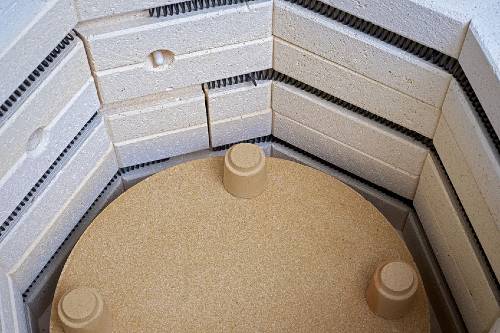
It’s important not to get hoodwinked into buying a used kiln simply because it comes with a lot of extras. Especially if these extras are not actually what you need. Nevertheless, new kiln furniture is an extra expense. So, if a kiln comes with furniture, it might save you some money.
Tip 10) Does the Kiln Manufacturer Still Exist?
Lots of older kilns are made by manufacturers that no longer exist. In itself, this isn’t a reason to pass up on a kiln. However, it’s preferable to buy a used kiln that is made by a manufacturer that is still in operation.
If you need to replace parts, you will most likely be able to get them from the manufacturer. This isn’t guaranteed, because manufacturers may no longer make the exact parts for a very old kiln.
Nevertheless, my experience of kiln manufacturers is that they are very happy to help with any technical issues. So even if they don’t make a particular part anymore, they are often very happy to talk you through alternatives. If the manufacturer is still trading, they will be an invaluable source of technical advice if you need it.
Tip 11) Download the Kiln Operating Manual
If you are interested in a particular kiln, then it’s a good idea to download the manual and read up on it. Even if the used kiln is old, you will usually be able to download a version of the manual. Sometimes these are scanned PDF documents and look dated. Nevertheless, the information that you need will most likely be there.
Tip 12) Regulations and Insurance
Using a kiln on your property may affect your insurance premium. It’s important to check this out with your insurance company. It’s also a good idea to check that having a kiln in your property, doesn’t go against any local regulations.
Final Thoughts
If you have been using a pottery firing service so far, then buying a used kiln is exciting. Finally getting to fire your own work is a big step in your journey as a potter. If you’re thinking of using your kiln at home, there are a few things to take into consideration. If you aren’t sure if you can accommodate a kiln in your home, check out this article first.

